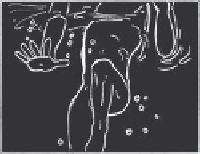Graphics Reference
In-Depth Information
the language to say it. Others (and I wonder whether I include mine here) have nothing particular
to say but say it beautifully. Not every i lm has to be full of subtext, and it takes as much expertise
to direct a simple children's i lms as it does a challenging adult i lm. Directing is not about
showing of , but I do think it is about making everything count and making considered decisions.
It's little wonder that my favourite director always will be Alfred Hitchcock. Today his i lms can
look restrained (there is little blood or actual violence in
Psycho
), his ef ects unsophisticated
(the Birds themselves and much ropey backprojection), his pacing rather too deliberate (it is
ages before the birds attack in
The Birds
), but they are brilliant i lms. Absolutely everything is
thought through to rel ect the narrative themes of his i lms. As Shakespeare meticulously, but
unnaturally, chooses words for their colour, tones and rhythms to rel ect his characters' situations
and dilemmas, so Hitchcock uses every element of i lm-making to say something, however great
or small, about his characters. Everything i ts in with some grand scheme; nothing appears as
a random choice. With stop motion, where we create everything from scratch, it takes no more
ef ort, time or money to create something that has some resonance or signii cance than it does
to create something that will merely do. It's not enough to paint something a certain colour
because it is pretty. Painting it a certain colour because it sets a mood, or because it suggests a
decision made by a character is far more interesting. A conversation between two people trying
to communicate in a room is more interesting if the setting allows a threat of interruption or a
ticking clock. Directing is about having a clear vision of the i lm and how all the elements can
give life to the story. Having characters doing things is not the only way to tell a story.
The Birds
is my favourite i lm from Hitchcock, possibly my favourite i lm full stop (although I see
Mary Poppins raising her parrot-headed umbrella at me with a look of betrayal). A brilliantly
constructed i lm, which doesn't give everything away, with every frame tightly constructed,
composed and balanced, all working towards the i lm as a whole. This can make i lms look too
arty, causing critics to spout clichés such as 'style over content, but good direction is about
getting this balance right, and Hitchcock does get it right. Some scenes in
The Birds
are self-
conscious, such as the succession of shots of a static Tippi Hedren watching the gulls at the gas
station. As a child I found this a little clumsy, as I did with Einstein's lion statues in
Battleship
Potempkin
. But some sequences in
The Birds
that are so perfectly thought out and appropriate
that you do not notice the tricks. The most famous sequence is the attack on the schoolhouse.
The arrival of the crows is plotted and choreographed so scrupulously that you want to call
out to Tippi Hedren to look behind her. When she does see that single crow that guides her
gaze to the bird-covered climbing frame, it is a deliciously shocking moment. It is a set piece,
a sequence that clearly has a structure and completeness, and has the audience thinking
'here we go. It is a self-consciously directed piece, drawing attention to its construction
and gimmicks, but it works, and it works because of so many elements. The use of sound is
particularly striking. The i lm is unique as it has no musical score, only the birds providing the
majority of the soundtrack. In this sequence, though, Hitchcock has the children, of screen,
singing a deliberately innocent, repetitive nursery rhyme. It is haunting and unsettling. Apart
from being a reminder of the children's presence, the repetitions crank up the
tension. Tippi Hedren, growing ever more unnerved with each verse, also cranks
up the tension by repeatedly l icking her cigarette and looking over her shoulder.
Small gestures replete with meaning.
Hitchcock uses colour to dei ne the characters, especially Tippi Hedren.
Throughout the i lm, she is dressed in a rather garish, unsettling and unnatural


Search WWH ::

Custom Search